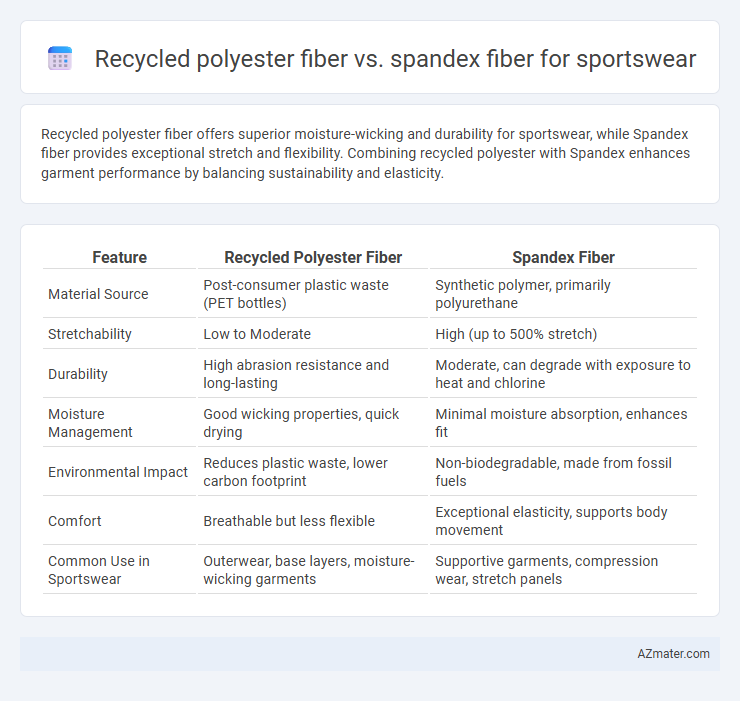Recycled polyester fiber offers superior moisture-wicking and durability for sportswear, while Spandex fiber provides exceptional stretch and flexibility. Combining recycled polyester with Spandex enhances garment performance by balancing sustainability and elasticity.
Table of Comparison
| Feature | Recycled Polyester Fiber | Spandex Fiber |
|---|---|---|
| Material Source | Post-consumer plastic waste (PET bottles) | Synthetic polymer, primarily polyurethane |
| Stretchability | Low to Moderate | High (up to 500% stretch) |
| Durability | High abrasion resistance and long-lasting | Moderate, can degrade with exposure to heat and chlorine |
| Moisture Management | Good wicking properties, quick drying | Minimal moisture absorption, enhances fit |
| Environmental Impact | Reduces plastic waste, lower carbon footprint | Non-biodegradable, made from fossil fuels |
| Comfort | Breathable but less flexible | Exceptional elasticity, supports body movement |
| Common Use in Sportswear | Outerwear, base layers, moisture-wicking garments | Supportive garments, compression wear, stretch panels |
Introduction to Sustainable Sportswear Materials
Recycled polyester fiber, derived from post-consumer plastic waste, offers excellent durability and moisture-wicking properties essential for sustainable sportswear, reducing environmental impact through resource conservation. Spandex fiber, known for its exceptional elasticity and stretch recovery, enhances comfort and fit in activewear, though it is typically produced from non-recycled petrochemical sources. Combining recycled polyester with spandex creates eco-friendly sportswear that balances sustainability with performance, meeting growing consumer demand for environmentally responsible athletic apparel.
What is Recycled Polyester Fiber?
Recycled polyester fiber is made from repurposed plastic waste, such as PET bottles, through a process that melts and reforms the material into new fibers, offering a sustainable alternative to virgin polyester. This eco-friendly fiber provides durability, moisture-wicking properties, and breathability, making it suitable for sportswear applications. Compared to spandex fiber, which is known for its exceptional stretch and elasticity, recycled polyester focuses more on environmental impact and performance in moisture management and fabric resilience.
What is Spandex Fiber?
Spandex fiber, known for its exceptional elasticity, is a synthetic fiber composed primarily of polyurethane, widely used in sportswear for its ability to stretch up to 500% without losing shape. Unlike recycled polyester fiber, which is made from repurposed plastic materials offering durability and moisture-wicking properties, spandex provides superior flexibility and comfort during high-performance activities. The combination of spandex with other fibers enhances the overall fit and movement, making it essential for apparel such as compression garments, leggings, and activewear.
Environmental Impact: Recycled Polyester vs Spandex
Recycled polyester fiber significantly reduces environmental impact by minimizing plastic waste and lowering energy consumption compared to virgin polyester production, while also offering durability and moisture-wicking properties ideal for sportswear. Spandex fiber, though essential for stretch and flexibility, poses challenges due to its non-biodegradable nature and reliance on fossil fuels in production, contributing to higher carbon emissions and long-term pollution concerns. Choosing recycled polyester in sportswear supports sustainability goals by reducing landfill waste and greenhouse gas emissions more effectively than spandex-based fabrics.
Breathability and Moisture Management
Recycled polyester fiber excels in moisture management by effectively wicking sweat away from the skin, enhancing breathability in sportswear designed for high-intensity activities. Spandex fiber, while offering superior stretch and flexibility, generally provides lower breathability and moisture-wicking properties compared to recycled polyester. Combining recycled polyester with spandex creates a balanced fabric blend that optimizes both moisture management and breathability for comfortable, performance-driven sportswear.
Durability and Strength Comparison
Recycled polyester fiber offers excellent durability and resistance to abrasion, making it highly suitable for sportswear that requires long-lasting performance under frequent use. Spandex fiber provides exceptional elasticity and stretch but has lower tensile strength and durability compared to recycled polyester, which may lead to faster wear and tear in high-intensity activities. For sportswear combining strength and flexibility, recycled polyester delivers superior toughness while spandex contributes critical stretch for freedom of movement.
Comfort and Flexibility in Sportswear
Recycled polyester fiber offers excellent moisture-wicking properties and breathability, enhancing comfort during intense physical activities while promoting sustainability. Spandex fiber provides superior stretch and elasticity, allowing for maximum flexibility and freedom of movement essential for dynamic sportswear designs. Combining recycled polyester with spandex creates a high-performance fabric blend that balances durability, comfort, and flexibility for optimal athletic wear.
Cost Effectiveness for Manufacturers
Recycled polyester fiber offers greater cost effectiveness for sportswear manufacturers by leveraging lower raw material expenses from post-consumer plastic sources and reducing energy consumption in production, leading to decreased overall manufacturing costs. Spandex fiber, although providing superior stretch and comfort, presents higher raw material and processing costs, which can increase final product pricing. Manufacturers aiming for sustainable yet affordable sportswear solutions often prefer recycled polyester due to its balanced performance and economic benefits.
Consumer Preferences and Market Trends
Recycled polyester fiber is gaining traction in sportswear due to rising consumer demand for sustainable and eco-friendly materials, offering durability and moisture-wicking properties preferred by activewear buyers. Spandex fiber remains popular for its superior stretch and flexibility, essential for performance and comfort in athletic apparel. Market trends indicate a growing blend of recycled polyester and spandex to combine sustainability with high functionality, meeting evolving consumer preferences for both environmental responsibility and enhanced wearability.
Choosing the Right Fiber for Sportswear Applications
Recycled polyester fiber offers superior moisture-wicking capabilities, durability, and eco-friendly benefits, making it ideal for high-performance sportswear that demands sustainability and long-lasting use. Spandex fiber excels in elasticity and stretch, providing exceptional flexibility and comfort for tight-fitting athletic apparel requiring freedom of movement. Choosing the right fiber depends on the specific sportswear application: recycled polyester for moisture management and environmental impact, spandex for enhanced stretch and shape retention.

Infographic: Recycled polyester fiber vs Spandex fiber for Sportswear
 azmater.com
azmater.com